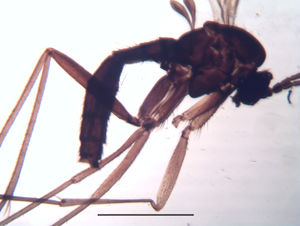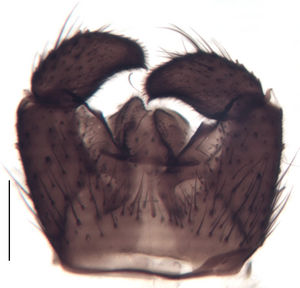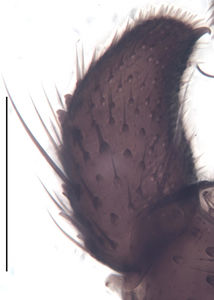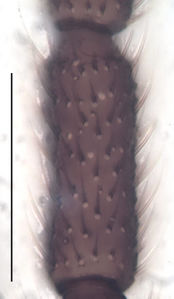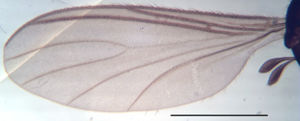Trichosiopsis subviatica hungarica
Ordo: Diptera
Familia: Sciaridae
Genus: Trichosiopsis
Species: Trichosiopsis subviatica
Name
Trichosiopsis subviatica hungarica unpublished
Type material
Holotype: ♂, 24.4.–8.5.2011, Malaise trap, leg. Doczkal & Szymank, KH8624 in ZSMC
Type locality
Germany, Baden-Württemberg, Grenzach-Wyhlen, Otto-Jäggi-Weg
Barcoded material
| Stadium | Country | Province | Locality | Habitat | Method | Date | Collector | Collection Number | Collection | Latitude | Longitude | Elevation (m) |
|---|---|---|---|---|---|---|---|---|---|---|---|---|
| 1 ♂ | Germany | Baden-Württemberg | Grenzach-Wyhlen, Otto-Jaeggi-Weg | Felsvorsprung im Sommerlinden-Flaumeichenwald | Malaise Trap | 24.4.–8.5.2011 | Dieter Doczkal & Axel Szymank | DIP 03669 | ZSMC | 48.0277 | 11.502 | 360 |
Other material studied
Germany: 3 ♂, Baden-Württemberg, Grenzach-Wyhlen, Otto-Jäggi-Weg, Felsnase, Malaise trap, Doczkal, 24.4.-08.05.2011, PKHH 8623/8626; Hungary: Heves, Szilvásvarad, Bükki Nemzeti Park, sweep netting, Rulik, 22.05.1998, PWMP 4032 [as Leptosciarella rejecta (part.) in Rulik et al. (2001[1]: 241)]. Italy: 20 ♂, Suldental bei Schmelz, montaner Fichtenwald, Malaise trap, Lange & Ziegler, 21.-31.05.2005, SDEI 2511–2428.
Description (male)
Head. Eye bridge 5 rows of facets. Antenna unicolour. LW-index of 4th flagellomere 2.4–2.7; neck 0.3–0.42 × segment width; transition of basal part to neck pronounced. Colour of neck unicolour. Antennal setae shorter than segment width; of normal strength; dense; adjacent. Palpus darkened; of normal length; palpomeres 3. First palpomere of normal shape, or thickened; with 5–9 setae; with only sparse sensilla. Second palpomere short and oval. Third palpomere as long as first. Thorax. Colour dark brown, or brown. Notum unicolour. Thoracic setae long and strong; black. Posterior pronotum bare. Mesothoracic sclerites bare. Legs. Colour yellow-brown, or brown. Hind coxa darkened. Setae on front coxa black, or darkened. Front tibial organ as patch of setae; dark; front tibial organ not bordered. Tibial setae on hind legs normal, shorter than tibial width. Tibial spurs of equal length. Claws untoothed. Wing. Wing slightly darkened; of normal shape. Wing membrane without macrotrichia. Wing venation weak, with faint stM. M-fork of normal shape. R1 ending at or slightly before base of m-fork; posterior veins with macrotrichia; stM mostly with macrotrichia; CuA1 and CuA2 mostly with macrotrichia; bM bare; r-m with few setae, or mostly setose; bM:r-M 0.95–1.17; st-Cu:bM 0.59–0.79; R1:R 1.4–1.6; c:w 0.65–0.75. Halter dark, or darkened; of normal length. Abdomen. Abdominal setae strong; dense; on tergites black; on sternites black. Hypopygium concolour with abdomen; LW-index 0.6–0.75. Base of gonocoxites with strong setae; gonocoxites broadly separated; inner margin of gonocoxites typically U-shaped; inner membrane of hypopygium scarcely setose; ventral margin of gonocoxite with short setae. Gonostylus elongate; LW-index 1.85–2.1; Inner margin concave; apex tapered, or equally rounded. Apical tooth present; without internal structure; of medium strength; LW-Index 2–3. Awl-like setae normal; present beneath apical tooth. Megasetae absent. Whiplash-hair absent. Tegmen 0.5–0.65 × longer than broad; rectangular with rounded edges; without special features; central process absent. Length of ejaculatory apodeme/hypopygium 20–28 %; base of ejaculatory apodeme present. Field with aedeagal teeth inconspicuous. Measurements. Body size 2.8–3.5 mm. Hind tibia 1.5–1.7 mm. Wing length 2.8–3.5 mm.
Diagnosis
Trichosiopsis subviatica hungarica is very similar to Trichosiopsis subviatica subelongata, only smaller. The gonostylus is not so equally tapered and the subspecies is the darkest of all.
DNA Barcoding
The COI sequence is not yet assigned to any BIN, because the only 552 base pairs were obtained from the only barxoded specimen. (n=1, K2P: 1.79%).
Etymology
The species name refers to Hungary, the country, from where the taxon was first recorded.
Discussion
This subspecies is genetically the most distant one of this difficult complex, even though that distance would in most other cases of Sciaridae still count for intraspecific variability.
Distribution
Germany, Italy, Hungary.
Images
|
References
- ↑ Rulik, B.; Mohrig, W.; Jaschhof, M. 2001: Trauermücken (Diptera: Sciaridae) und freilebende Gallmücken (Diptera: Cecidomyiidae: Lestremiinae) aus Ungarn. Mit Bemerkungen zur Corynoptera tridentata-Gruppe. Folia Entomologica Hungarica, 62, 231-245.
